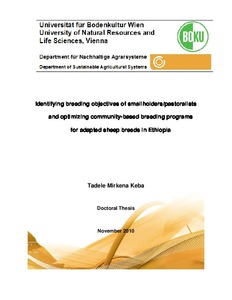Resource information
The aim of this thesis was to identify breeding objectives of smallholder and pastoral sheep keepers in Ethiopia (Afar, Bonga, Horro and Menz areas) and to design appropriate community-based breeding plans for genetic improvement of four indigenous sheep breeds. Information on genetics of adaptation in farm animals was reviewed. Two live animals ranking experiments approaches, own-flock and groupanimal ranking, were used to identify sheep breeding objectives. In own-flock ranking, owners paid more attention to production and reproduction performances and behavioral traits (e.g. milk yield, temperament, lamb growth, mothering ability, body size, lambing interval). In group-animal ranking, observable attributes like coat color, tail type, ear size, body size, etc. recurred. Afar (pastoral) and Menz (sheepbarley) sheep breeders, coping with more challenging production environments, considered more attributes compared to the two crop-livestock systems (Bonga and Horro). Four scenarios of ram selection and ram use were compared via deterministic simulation of breeding plans for community-based sheep breeding programs considering the top three most important traits identified. The review work revealed the need to identify the most appropriate and adapted genotypes capable of coping with environmental challenges posed by the production systems or, wherever possible, adapt the environments to the requirements of the animals. In conclusion, both own-flock and group-animal ranking experiments can serve as tools in objective traits identification in production systems without recording practices. Strong selection and short use of rams for breeding were the preferred options. Expected genetic gains are satisfactory but rely on continuous recording.



